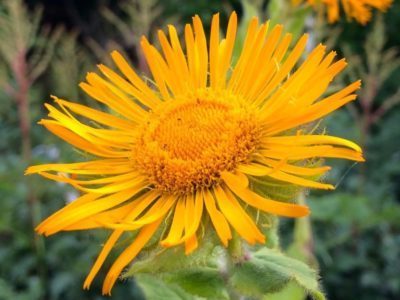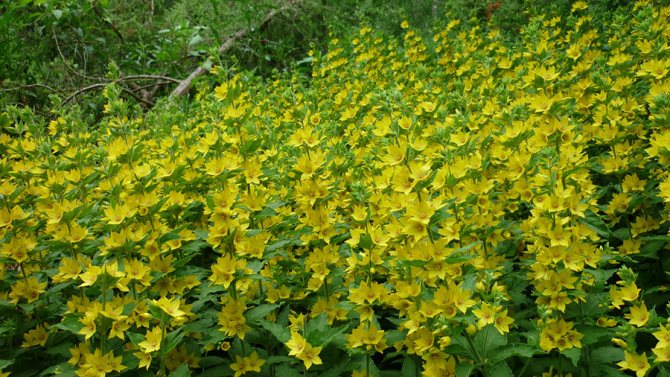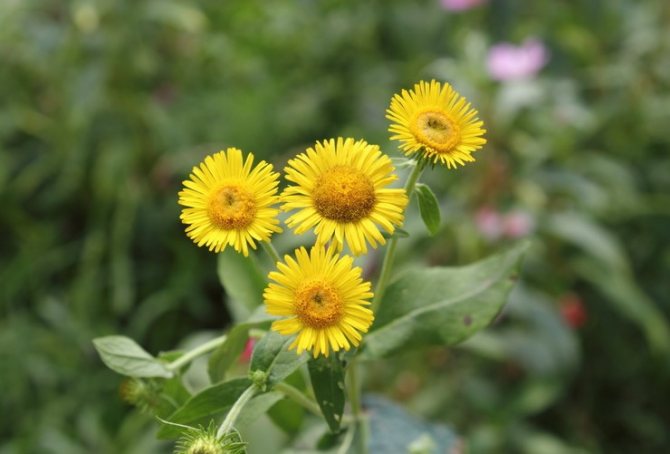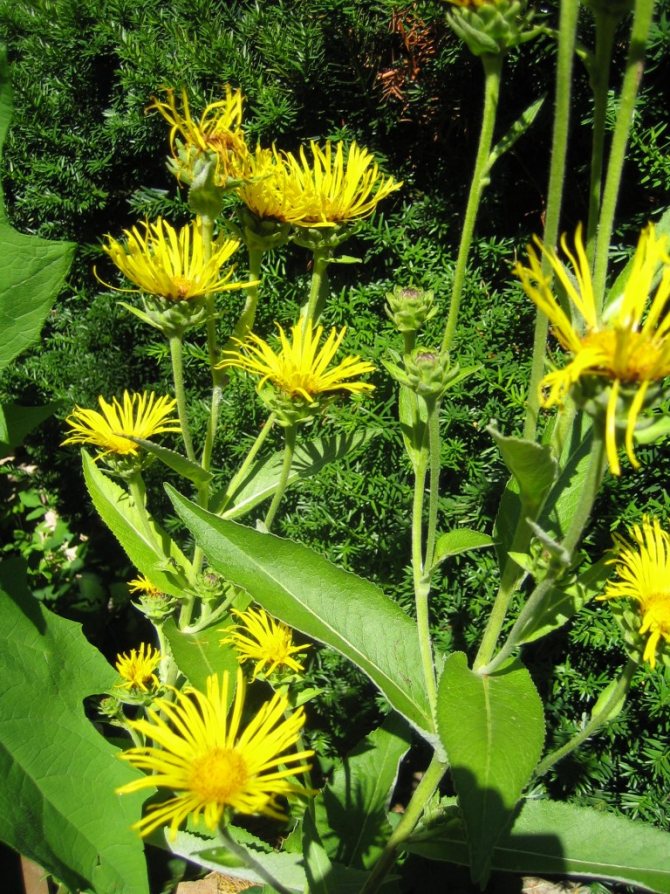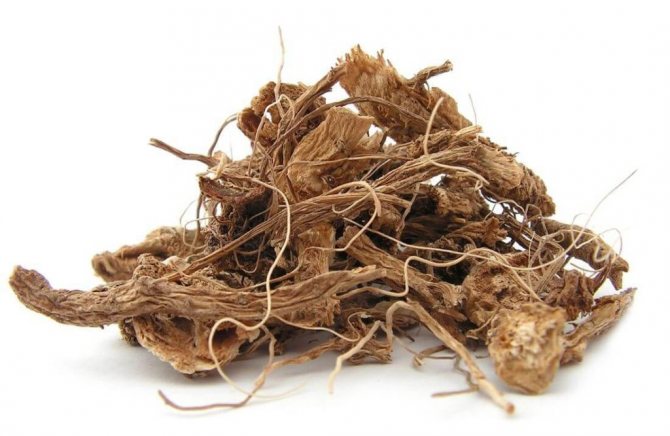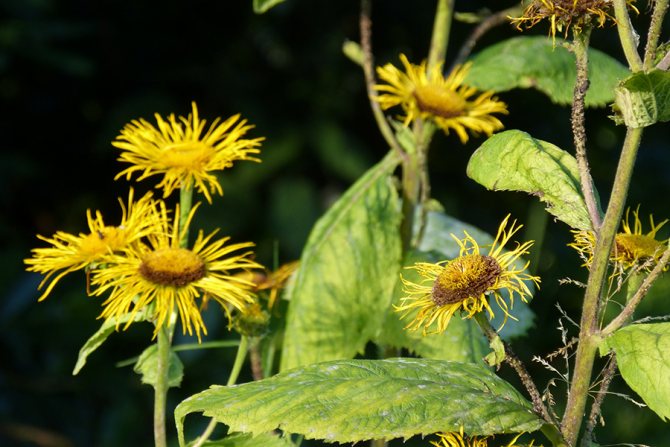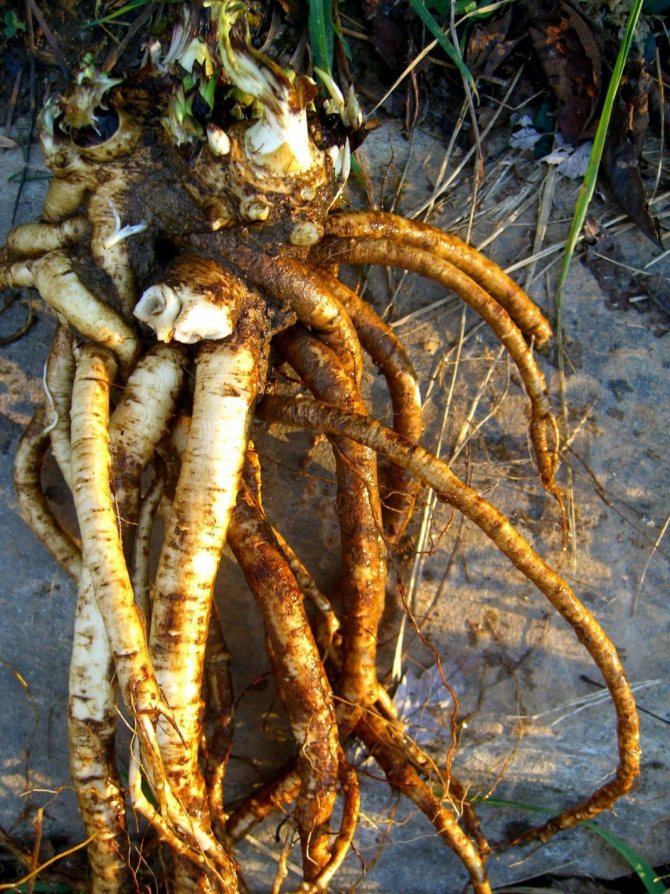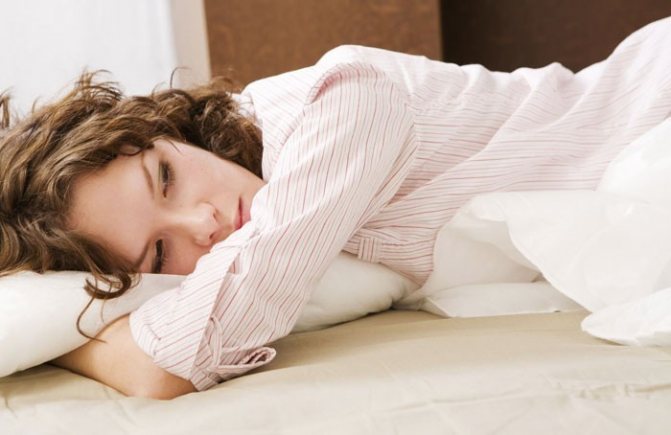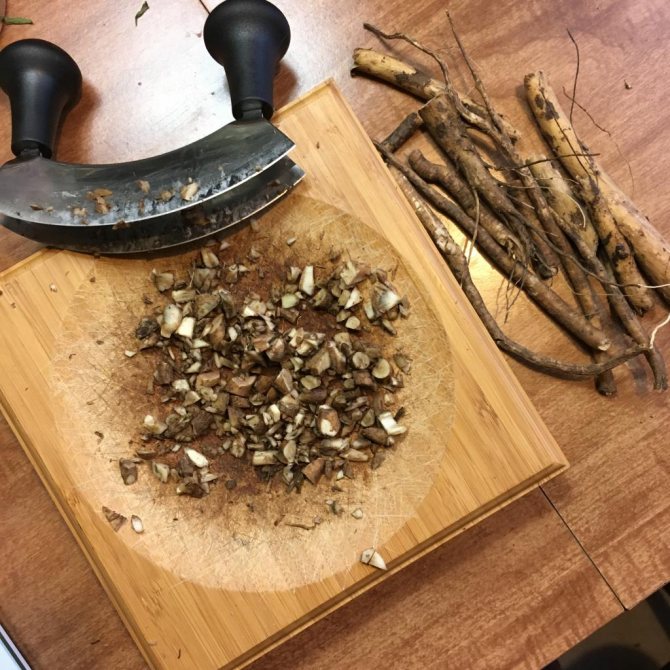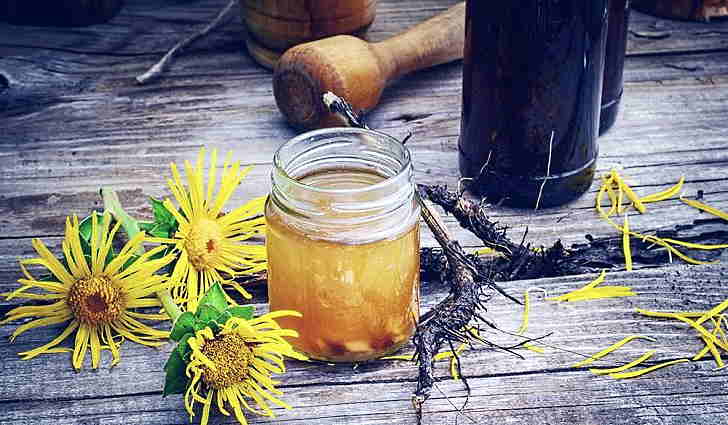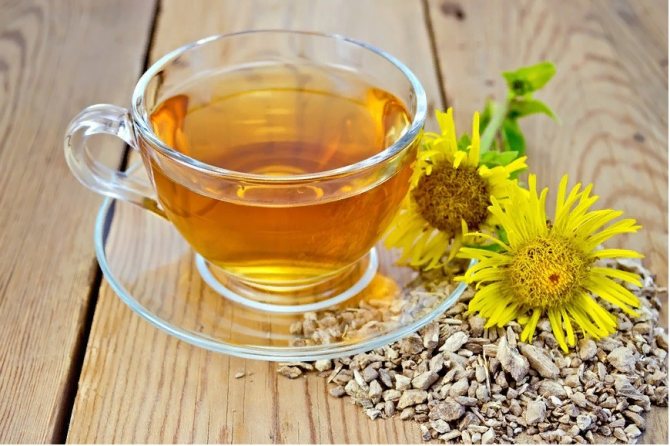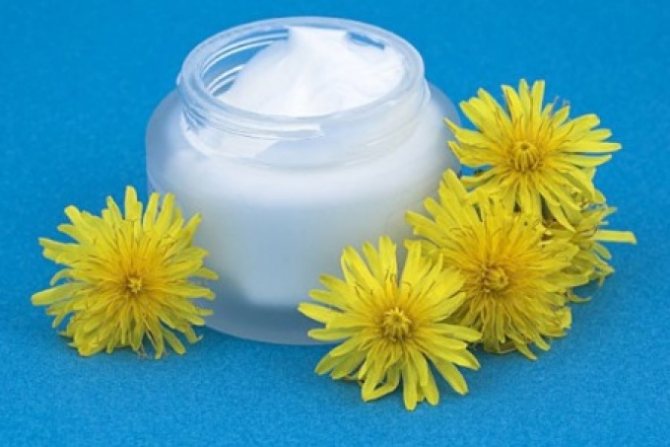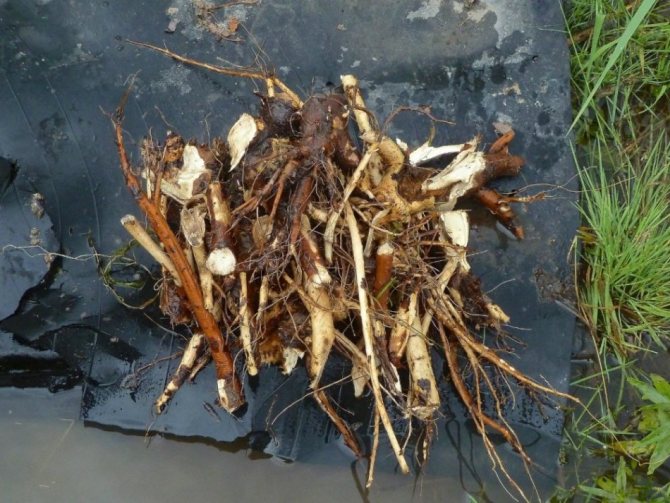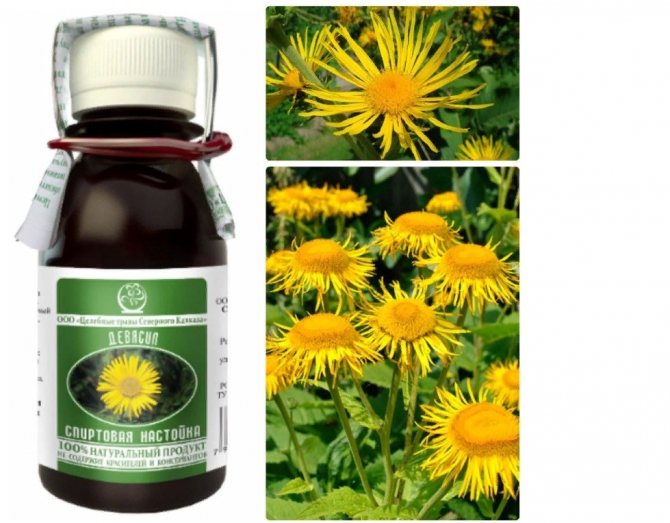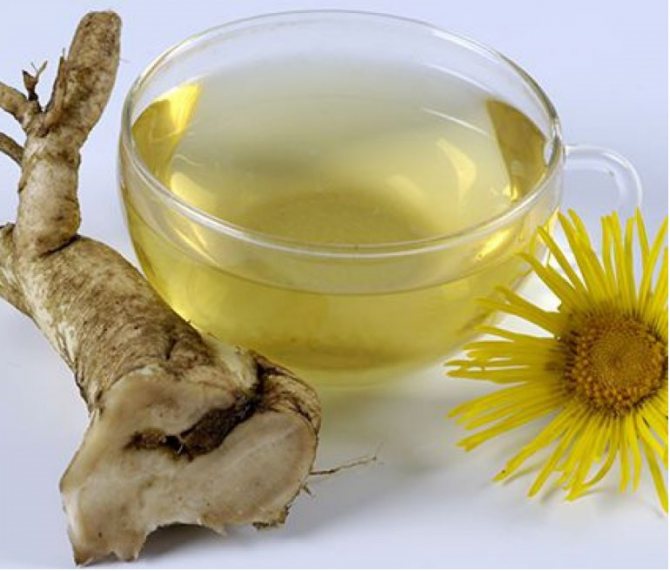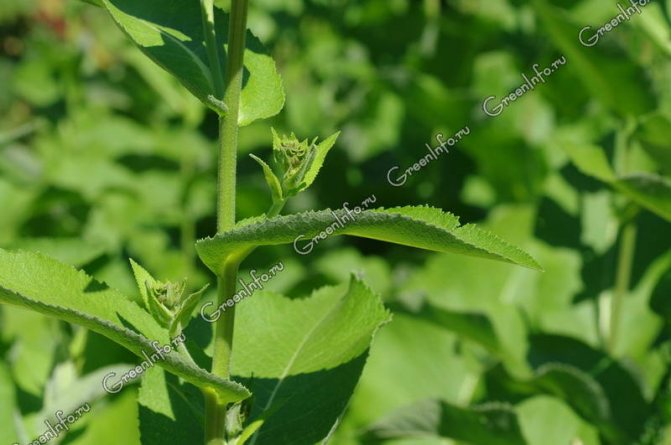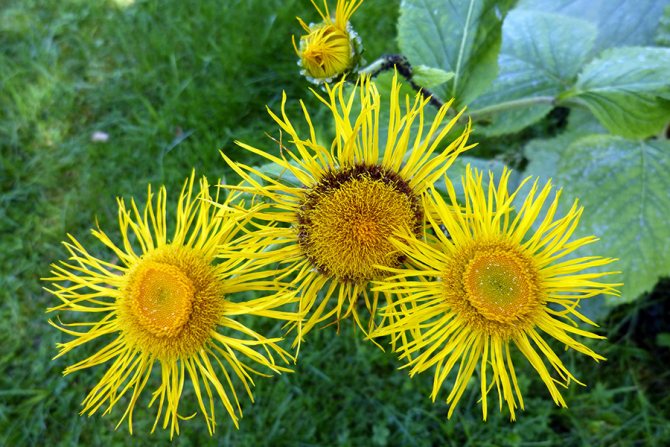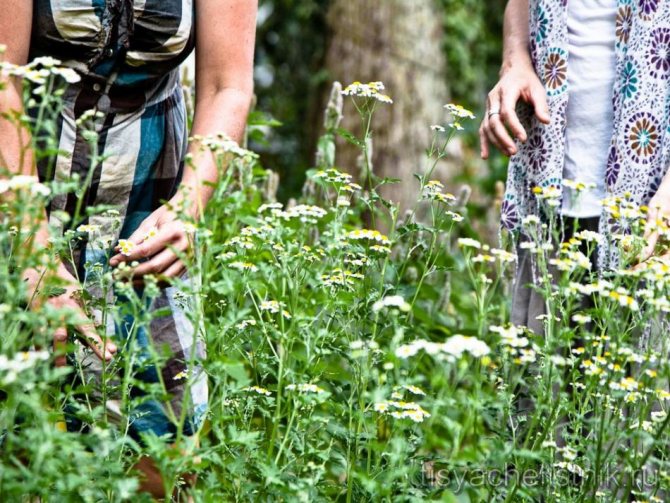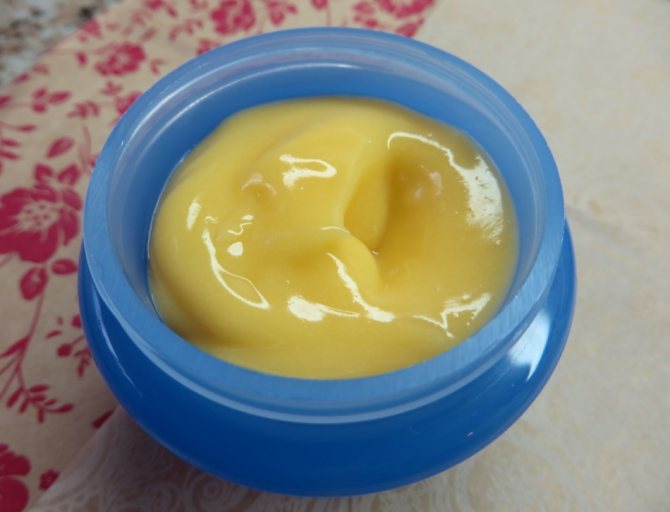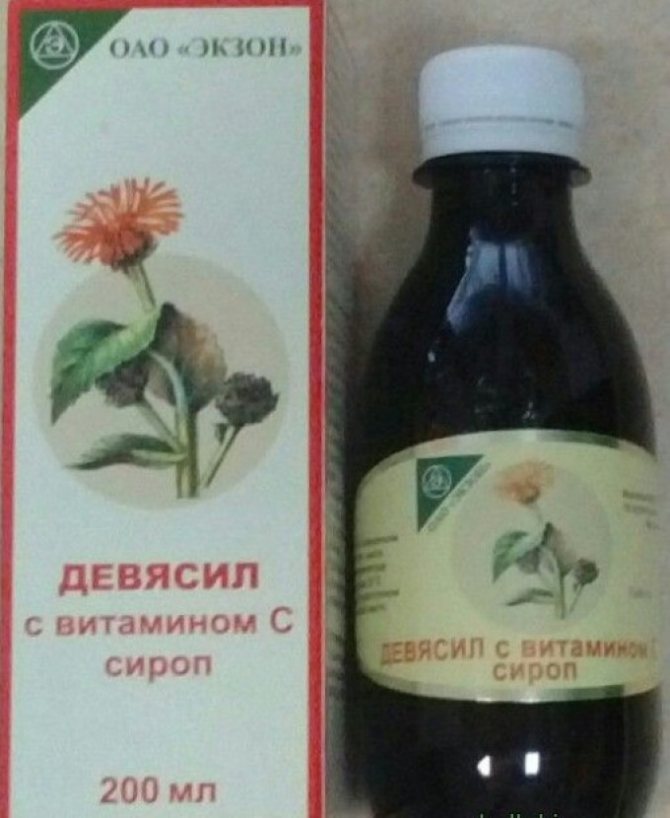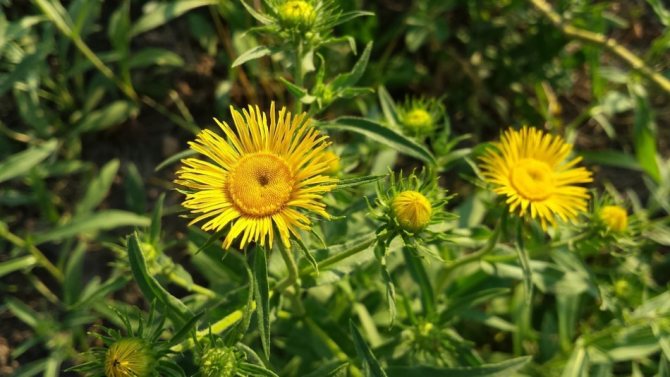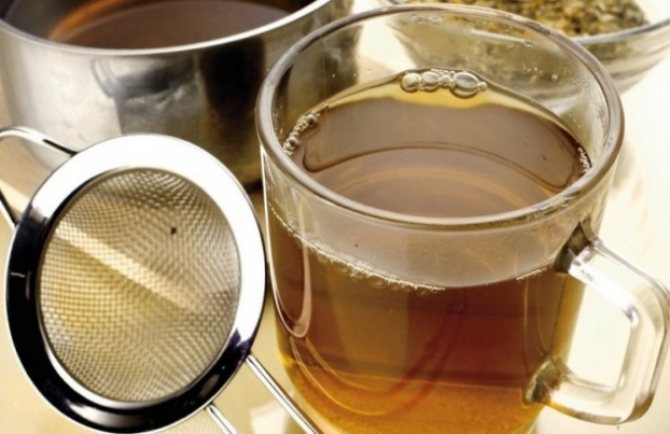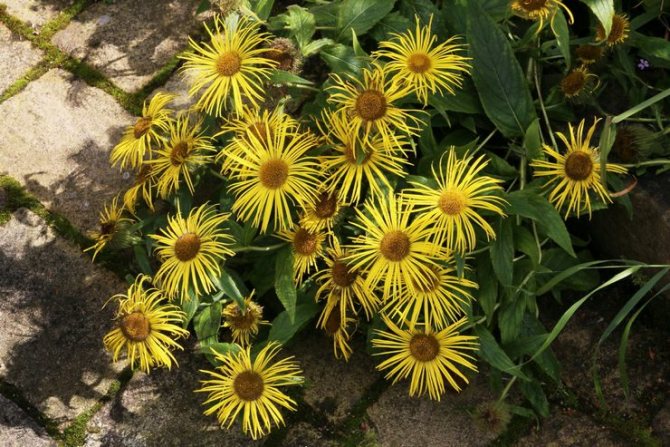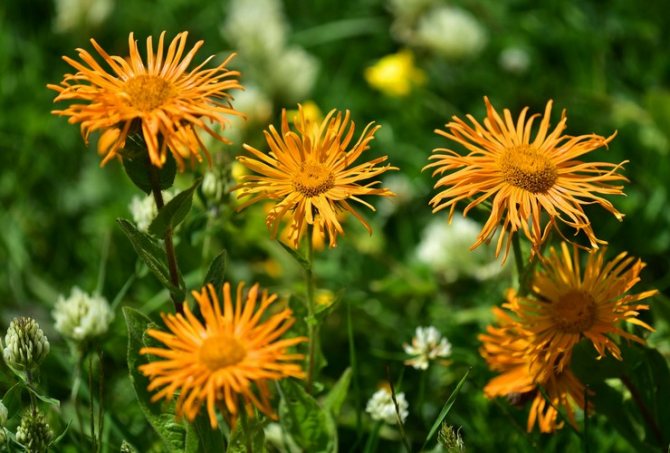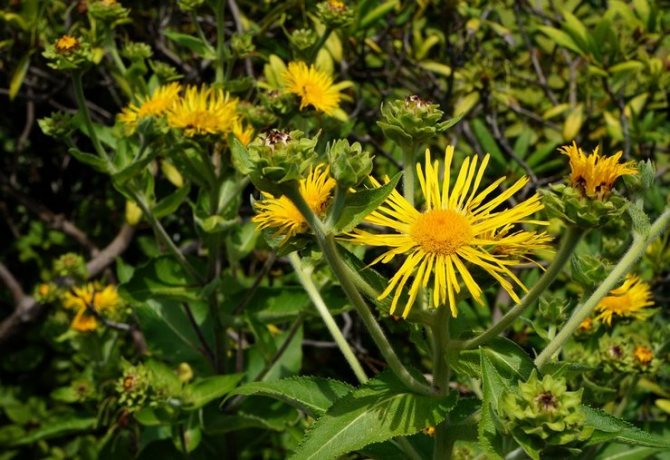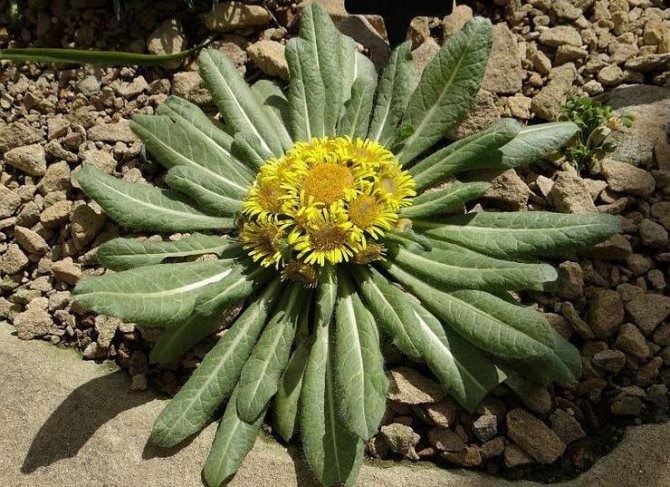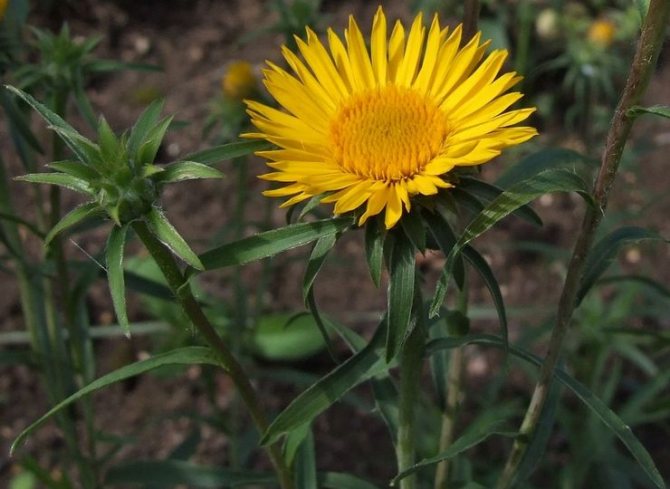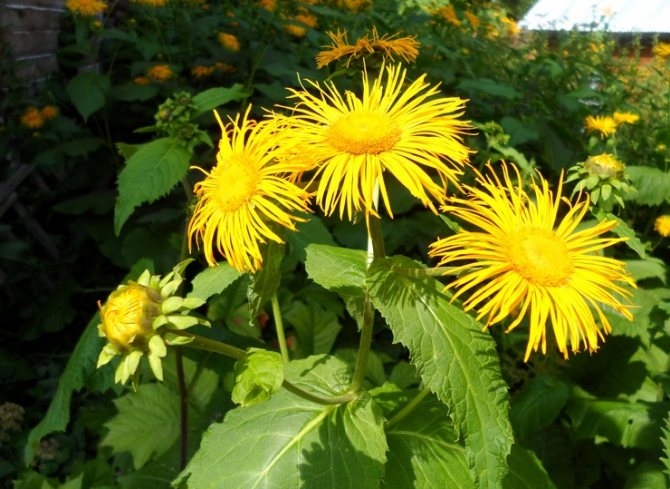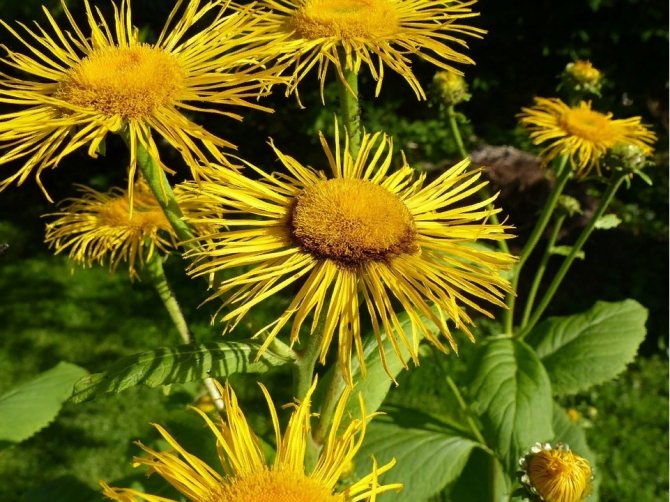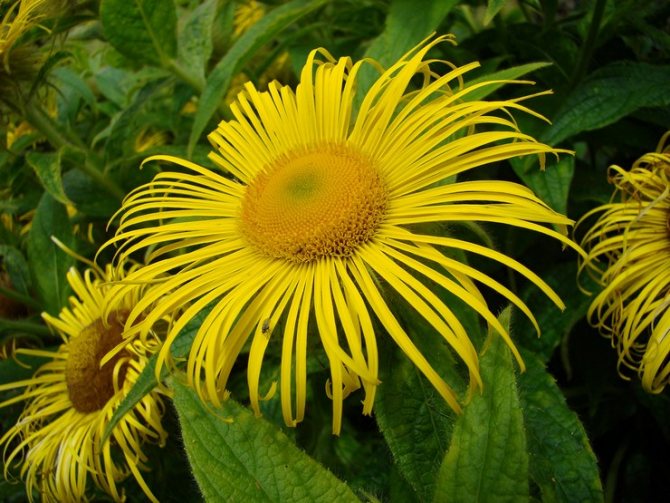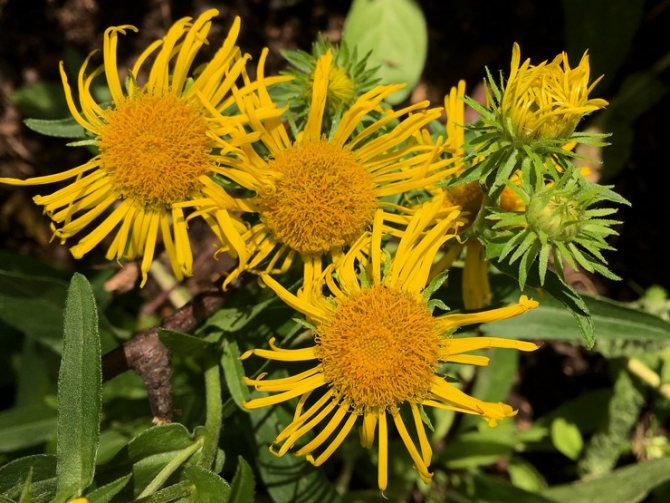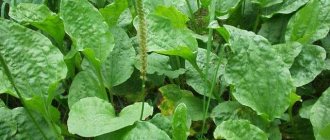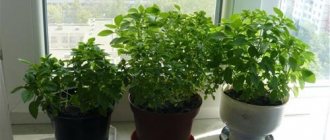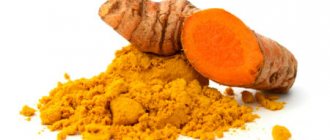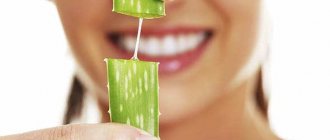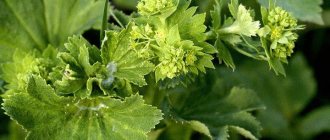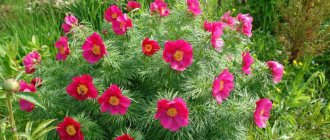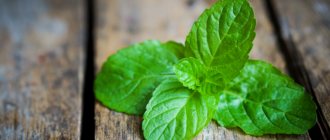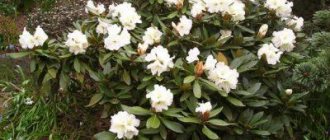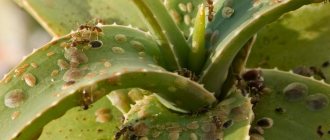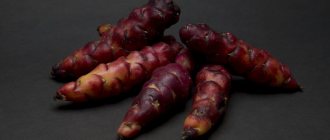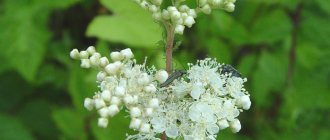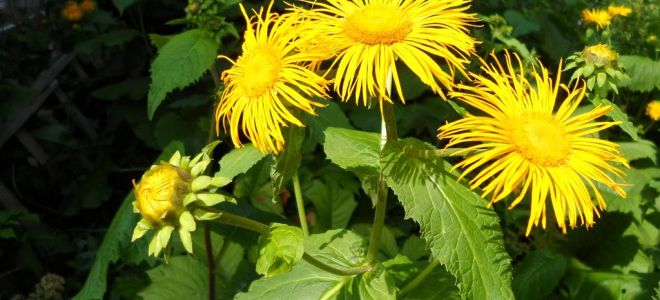
The main therapeutic use of elecampane high (Inula Helenium), in particular the root, is used in otolaryngology, for the treatment of lungs, diseases of bronchitis and tonsillitis, also as an expectorant. Others use elecampane to improve stomach function, treat nausea and diarrhea, and treat parasites that live in the stomach.
Description of the plant
The herbaceous plant is a perennial, part of the Aster family. The stem reaches 2 meters in height. The root is juicy, large and often multi-headed. The stem is hairy.
It blooms from late spring to early autumn. Ripens from August to October. It grows in deciduous and pine forests, along the banks of rivers and lakes. The 3-year-old plant has the greatest value. It has the highest concentration of vitamins, trace elements, useful compounds.
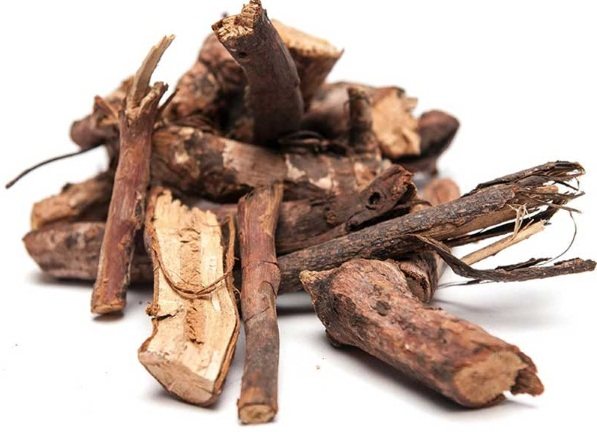

Only rhizome is used as a medicine. Darkened and damaged areas are cut off. After washing, the root is cut into slices.
From elecampane you can:
- boil the broth
- make a tincture
- prepare a cream or ointment
- make tea
- arrange a bouquet
- make jam
Culinary use
Dried elecampane root has a spicy taste and delicate aroma with floral notes. It is used as a substitute for ginger in baked goods., in the manufacture of wines, marinades. Add to soups, cereals, side dishes, compotes.
The oil is used to flavor alcoholic beverages, coffee, tea.
Candied fruits are distinguished by their original taste.
Jam
You will need 1 kg of fresh rhizome, 500 g of sour berries or fruits.
Preparation:
- finely chop the root, boil until half cooked, drain the water;
- add berries and 1.5 liters of water;
- simmer for 2 hours.
Instead of berries, you can use rhubarb or sorrel.
Oatmeal "Health"
Pour two tablespoons of the chopped root with a glass of water, cook until half cooked.
Add oatmeal (400 g), two glasses of milk, salt and sugar to taste. Bring to readiness.
Chemical composition
The rhizome contains more than 40% inulin polysaccharides, vitamin E, resin gum, and many other substances.
| Inulin and inulenin | A source of energy, fills with strength, removes fatigue, drowsiness. Helps the body absorb vitamins needed during the recovery period faster. Improves the intestinal microflora, strengthens the immune system and lowers the concentration of sugar in the blood. Therefore, it is beneficial for diabetics. |
| Saponins | They soothe inflammation and stimulate the active work of hormones. They have a laxative side effect. Tones up and acts as an expectorant. Reduces cholesterol levels. They can be found in beans, peas, and peanuts. |
| Acetic and Benzoic Acids | Fight inflammation by calming it down and killing the virus. They increase immunity, help fight viruses for colds. Strengthen the protective barriers of the body. They kill fungi and germs. These acids can be found in lingonberries, cranberries, and fruit juices. |
| Pectin | Reduces cholesterol levels. It binds all toxic compounds and helps them get out of the body, thereby ridding it of toxins and toxins. Strengthens blood vessels, restores the nervous system and enhances the effect of vitamin C. Reduces the risk of cancer.It can be found in currants, beets and apples. |
| Ascorbic acid | Helps to accelerate the growth of cell tissue, improves immunity and capillary permeability. Helps the production of adrenal hormones. Most of all it is in the rosehip. |
| Iron | Increases hemoglobin, synthesizes thyroid hormone, produces vital enzymes and improves immunity. Pork liver contains the most iron. |
| Calcium | Helps blood clotting, building material for bones and teeth. Stabilizes the work of the heart muscle and nerve cells. Calcium can be found in seeds, cheese, and yogurt. |
| Potassium | Eliminates edema, prevents the development of atherosclerosis, normalizes blood pressure and removes toxins. Relieves allergies. Strengthens blood vessels, capillaries. Most of all it is in tea and dried apricots. |
| Magnesium | Removes toxins, normalizes body temperature and the functioning of nerve cells. Prevents the formation of kidney stones. Increases energy levels in the body and relieves fatigue. Helps to relax muscles and nervous system, which is necessary to maintain full health. Most of the magnesium is found in spinach. |
| Manganese | Helps the absorption of carbohydrates, normalizes the nervous system, synthesizes insulin, preventing the development of diabetes. It is especially important to use it for those who have a predisposition to diabetes. Helps to form the fetus correctly during pregnancy. Most of all it is found in hazelnuts. |
Beneficial features
Basically, all useful substances are concentrated in the rhizome of the plant:
- vegetable resins
- wax
- ether compounds
- vitamin E
- 44% insulin polysaccharide
Elecampane rhizome, decoctions and tinctures prepared with its addition, teas and powder are used for problems with the gastrointestinal tract of the inflammatory nature of their course and liver and kidney diseases, helps to relieve inflammation and has pronounced diuretic and anthelmintic properties.
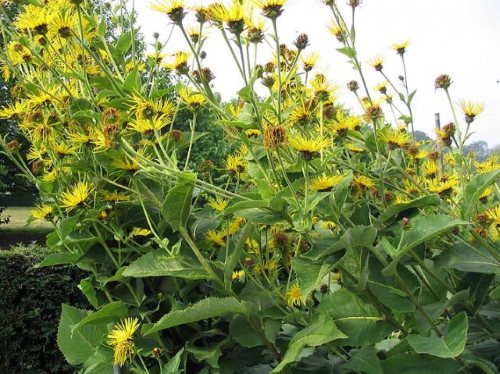

Elecampane high
Vitamin E, part of the rhizome, helps to stop the degenerative aging processes, which is especially important for elderly people, since it is he who is a natural and quite powerful antioxidant. A decoction of the medicinal root is also indicated for many skin diseases - it is enough to treat the affected skin with a strong decoction. Rashes and lichens, dermatitis and other rashes, scabies - resins and mucus present in the rhizome, the camel helps to overcome them, having a beneficial effect on the digestive tract, protecting the mucous membrane, pharynx.
Healing properties of the root and herb
The agent has an expectorant effect, lowers the temperature in viral diseases, increases immunity, removes toxins and bile from the body. The root is useful in diabetes mellitus, as it is rich in inulin.


Healing properties of elecampane root
Side effects can include heartburn and itching. Before using the medicine, you should consult a doctor, individual intolerance is possible.
Sometimes the inflorescence is involved in the creation of perfumes or in the composition for bouquets. With inflammation of the stomach and bronchial asthma, the root of elecampane is brewed along with the herb. So the medicine has a stronger effect on the body and improves the functioning of all digestive organs.
Growing at home or in the garden
On the territory of Russia, elecampane grows well in the European part of the territory and in the vastness of Western Siberia, preferring wet places near rivers and lakes, natural reservoirs and lowlands. In such a matter as growing at home and in the country - it is most often grown as an ornamental plant, somewhat less often as a medicinal plant.
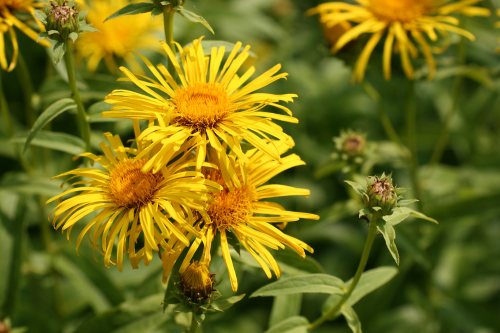

Elecampane
You can propagate elecampane in your own area both with the help of seeds and by dividing its rhizome. With regard to growing by seeds, they are sown in open ground for the winter, or stratified and sown in the spring.In this case, elecampane will bloom in the second year, but as a medicinal raw material, it can only be used for 3 years.
Breeding a plant by dividing the rhizome is a simple and quick way to get new bushes in your area.
It is best to divide the rhizome in the spring, when the juice flow is started and the first shoots begin to break out - as a result, you get a part of the rhizome with a new bud of renewal.
Experienced gardeners recommend keeping a minimum distance of 70-80 cm between bushes when planting. So you get a powerful plant with a well-developed root system. Otherwise, the bushes will grow smaller, oppress each other, and in the end they may simply die.
Indications
Elecampane root exhibits medicinal properties in diseases of the stomach, heart, lungs. It relieves pain and relieves gastritis symptoms by activating protective barriers throughout the body.
Most often, the plant is used as the prevention of gastrointestinal diseases. The root speeds up metabolism, relieves spasms. It has antihelminthic and diuretic properties. Its use is indicated for people with diabetes mellitus and endocrine system problems, it normalizes the work of hormones, fights against anemia and oncology.
Elecampane acts as an antiviral, antiseptic, solves problems with conceiving a child, increasing the vital activity of sperm.
It also increases appetite and calms the nervous system. It can be used as a prophylactic agent during the absence of diseases.
Infusion
It is necessary to pour 1 tablespoon of elecampane root with a glass of boiling milk or water. The drink should be infused for 10-15 minutes. and drink on an empty stomach. Then it inhibits the development of Candida bacteria in the mouth and intestines, has a choleretic and diuretic effect. Ground elecampane root is taken orally as a prebiotic (source of inulin), 1 teaspoon each or after mixing with honey as a tonic, choleretic agent, to improve digestion and treat inflammation of the throat, trachea and bronchi.
Dressings soaked in infusion are used for skin diseases, difficult healing wounds, chirias, eczema, bruises, as well as for post-traumatic edema, burns.
Contraindications
You can not use a drink from the root in case of individual intolerance.
And also the drug is prohibited:
- with chronic vascular diseases;
- gastritis;
- hypotension;
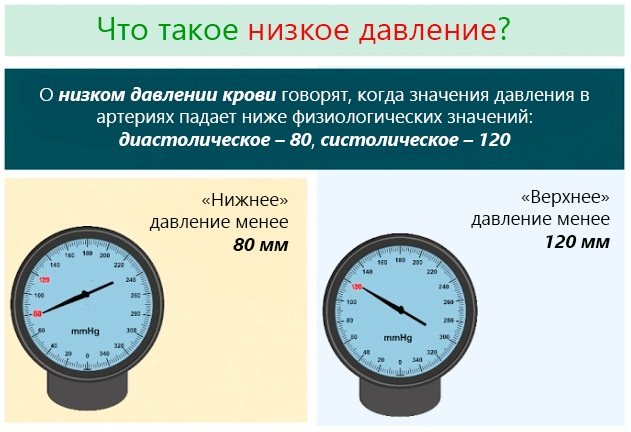

- heart problems;
- pregnancy;
- nursing mothers;
- chronic constipation.
It is contraindicated to use the broth for children under three years old, it is allowed from 3-12 only with a doctor's indication. The drug can have an unpredictable effect on the child's body. To avoid the consequences, it is better to exclude it during pregnancy and lactation.
Uncontrolled intake of the drug without the supervision of a doctor can worsen the state of health.
In case of kidney disease, the drug is also dispensed after consulting a doctor. Elecampane has a diuretic effect, which will create a strong stress on the kidneys, they may not be able to withstand it.
In the case of heavy menstruation in women, it is also better to refuse the drug. It increases the amount of discharge, which can negatively affect women's health.
The first signs of elecampane poisoning can manifest itself in the form of nausea and lethargy, possibly profuse salivation, loss of coordination, even a coma.
Name
The elecampane plant itself got its very consonant name due to its own unique abilities - it is often called a cure for 9 diseases. He was known by the healers of Ancient Rome and Greece, India and China. Latin name - Ínula
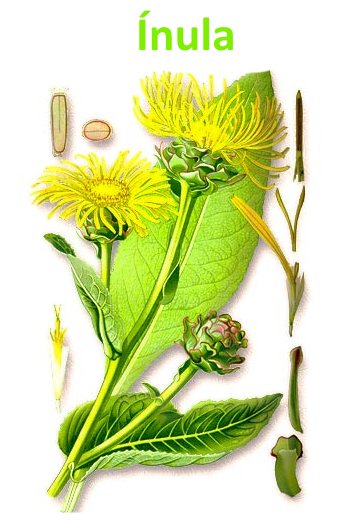

Ínula
In its history, the name of the plant elecampane has 3 versions of its origin:
- First of all, the name of the plants known as elecampane tall - "helenium" comes from the ancient Greek word "helos", which literally translates as swampy meadow.
- The second version of the origin of the name elecampane takes us back to the history of ancient Greece - it is based on the word "helios", which literally translates as the sun.
- The third and most beautiful version of the origin of its name is from the name of the most beautiful goddess of the Ancient Greek pantheon, Helen, the daughter of the great Zeus, and from whose tears this plant grew on earth.
But as noted above, in Russia it was known as a plant for 9 diseases.
Features of use for women, men, children, daily norms
Elecampane root helps the female body with delayed menstruation. He sets up a cycle. Before treating with the root, you should find out the true cause of the broken cycle.
Elecampane root is suitable for use in case of delay of less than 10 days. In case of regular cycle failure, you must contact a qualified gynecologist.
Grind the fresh rhizome (or use dried), scald with boiling water, let it brew for a quarter of an hour. Boil for about 30 minutes. Take a teaspoon 5 times a day. This method cannot often be used. Elecampane is a potent medicine, be careful.
The absence of a cycle for a period of more than 3 months indicates a downed hormonal background, in such a situation it is necessary to consult a doctor. He will select the necessary medicines and restore women's health.
For men, the root will be beneficial for men's health and potency. Also, a decoction in small doses has a positive effect on the heart.


An adult should not consume more than two glasses of broth per day. For children from 5 to 15 years old, no more than a quarter of a glass.
Growing conditions
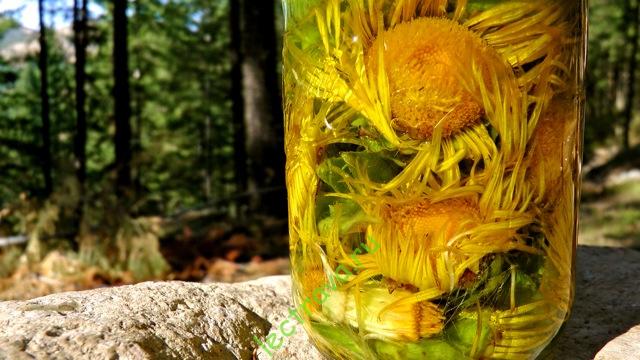

Elecampane prefers a lot of sun, a little shade and has an average water requirement. All soil types are tolerable, but moist, acidic to neutral loam is ideal. Slightly moist, well-drained soils will lead to higher productivity as it mimics the natural habitat. During periods of extreme heat and dry conditions, it will need additional water. Propagation is by seed or root cuttings.
Recipes for folk remedies, instructions for use
The most popular recipes for treatment are decoctions and tinctures. But there are ointments, teas, dry application.
With sore joints
Elecampane root reveals healing properties in the fight against regular pain. The presence of pain in the joints indicates serious problems.
For recovery, it is necessary to identify the main cause of the disease and only then remove the symptoms. For prophylaxis, the root is taken internally in the form of a decoction. They also relieve pain and soothe joints.
For cooking you will need: 1 tbsp. l. burdock + 1 tbsp. l. elecampane. Mix herbs and pour in a liter of water. It takes 30 minutes to cook a medicinal drug. Leave the medicine for half a day in a warm place to infuse. Take orally 2 tbsp. l. in the morning and 2 tbsp. l. in the evening.
To prepare a bath, you can use the same broth, or prepare a new one with a higher concentration of herbs. Add a liter of broth to the bath. The course of therapeutic bathing no more than 15 times. Baths can be combined with taking the medicine inside.
For dermatological diseases
Elecampane root reveals medicinal properties in the fight against gastrointestinal problems. Increases immunity, eliminates dermatological problems, relieves itching, swelling and inflammation.
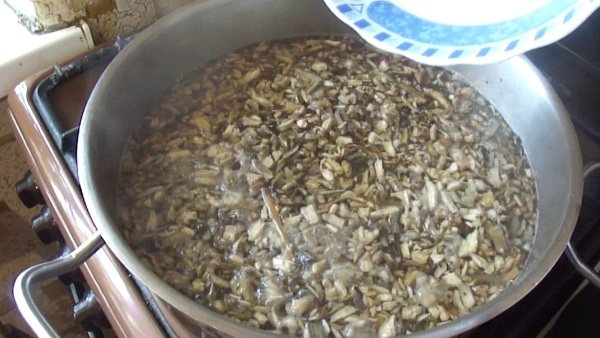

We are preparing a decoction for washing skin rashes and other dermatological problems. For 100 g of dry root, 1 liter of hot water is needed. Insist 4 hours and separate the liquid by filtering it through cheesecloth. These washings relieve itching and soothe inflammation. Perform the procedure daily.
With tuberculosis
For lung disease, grate two glasses of fresh elecampane root. Insist on 500 ml of vodka for 9 days.Apply this medicine internally in a tablespoon before eating, daily. Apply in a course of two months.
There is a collection from tuberculosis, which acts as an adjuvant. Pour 3 cups of hot water over a tablespoon of comfrey root, spring primrose flowers, linden inflorescences and elecampane for 12 hours. Such a broth should be drunk 2-3 times a day for half a glass, having previously filtered it through cheesecloth.
For gynecological diseases
The tincture is prepared for oral administration, as well as for soaking tampons with it. 2 tbsp. l. spoons of the root are poured with 500 ml of vodka and insisted for 3 weeks. This broth relieves inflammation and restores the cycle.
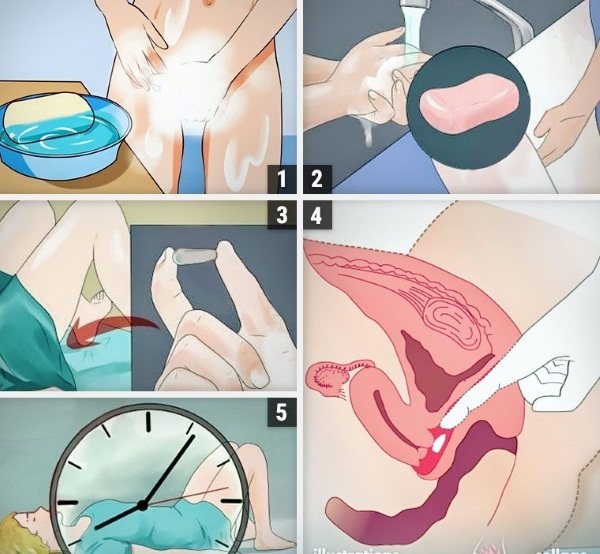

Tampons are placed at night, inside, take 50 ml daily, in a course of 10 days.
Elecampane root has special properties. But treatment procedures are best done after consulting a professional gynecologist.
With delayed menstruation
For persistent and long-term delays, it is necessary to see a gynecologist. The broth can only help with delays of several days. When the cycle gets lost on a regular basis, self-medication will not help here. It is necessary to identify the root cause and treat the root cause of the problem.
The broth is prepared for one day. Pour 20 g of grass with hot water and cook for a quarter of an hour. Let cool and take in small portions throughout the day. After the onset of menstruation, the medication should be stopped, otherwise the discharge may be more abundant than before.
With a cold
The broth is prepared from a tablespoon of the collection and a glass of hot water. Boil the mixture for 15 minutes and drink a large spoonful every hour throughout the day. With strong virus attacks, you can drink the broth instead of tea. This medicine can be used to gargle.
It is recommended to do herbal inhalation. Add honey and lemon to the diet.
For intestinal upset
An intestinal disorder is familiar to everyone. In addition to decoction of herbs, you must drink plenty of water to avoid dehydration. You should also use medications that will help fight the virus.
The broth is quite simple to prepare, pour a small amount of the herb with hot water and cook for a quarter of an hour. After removing from heat, leave to brew for a couple of hours. Drink half a glass before meals.
With colitis, gastritis
Take a teaspoon of ground dry root twice a day and drink it with water. This powder heals small ulcers and improves the general condition of the gastrointestinal tract. Relieves pain, normalizes the functioning of internal organs. Recommended for indigestion.
With stomach ulcers
Grass elecampane is the best assistant for those who suffer from gastrointestinal diseases. He is especially good at treating small ulcers and relieves pain. It can be used in between treatment as a prophylactic agent.
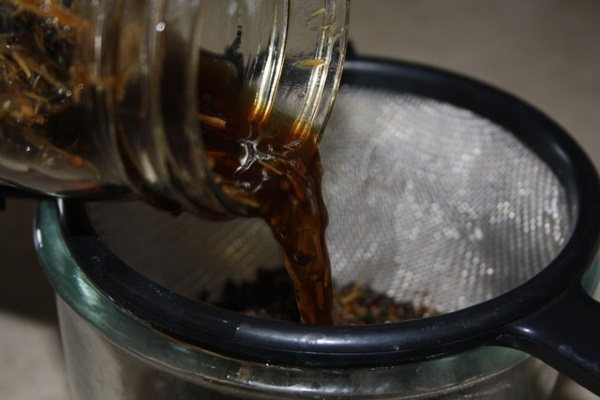

The simplest broth is harvested for a couple of days. 1 tsp dry collection is diluted with a glass of boiling water and cook for a quarter of an hour. After the broth, it is necessary to infuse so that the elecampane gives all its beneficial properties to the water. This process takes no more than 4 hours. Drink a tablespoon three times a day.
For chronic cough
Elecampane root shows medicinal properties not only for problems of the digestive system, it also helps with chronic colds. It can help both children and adults. Elecampane facilitates expectoration, softens cough, removes phlegm. Strengthens the immune system and kills the virus.
It is very simple to prepare the broth. 1 tbsp. l. elecampane root is scalded with a glass of boiling water and cooked for half an hour. For ingestion, dilute the broth with water in a 1: 1 ratio. You can add honey and fruit for a more pleasant taste. Drink a quarter glass before meals. The broth is used for rinsing the throat, inhalations, compresses.
With asthma
Drink a decoction daily, for greater effect, along with a small spoonful of honey. The broth is easy to make. Pour a spoonful of ground root with a glass of water and cook for a quarter of an hour.It is better to prepare a new medicine every day, so the effect will be achieved faster and the necessary properties will be preserved. The drink can be stored for a maximum of 24 hours.
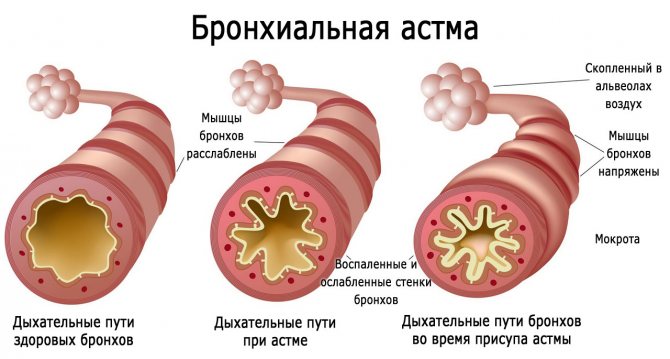

Also, with chronic bronchial asthma, it is recommended to use elecampane juice along with honey. This recipe is easy to prepare and very useful for a tired body.
For inflammatory processes
Elecampane prevents inflammation and the development of viral diseases. The broth is cooked for 10-15 minutes. 1 tbsp. l. scald with boiling water and cook over medium heat for about a quarter of an hour. When the medicine has cooled down, you can drink it or apply it topically.
Drink a quarter cup in the morning and a quarter cup in the evening. Wipe off skin inflammation every day before bed.
To strengthen the immune system
In the autumn-spring period, diseases and microbes constantly fly in the air. At this time of the year, support for the body is vital. Then you don't have to worry about skipping school or missing work.
The medicine is prepared from dry elecampane, which can be purchased at any pharmacy. Taking 2 tbsp. l. pour the mixture with 500 ml of boiling water and cook for no more than a quarter of an hour. Remove from heat and leave to cool for a couple of hours. Store in the refrigerator for no more than 24 hours. Drink instead of tea, adding honey.
For the cardiovascular system
The broth helps to stabilize the work of the heart and strengthen its health. A simple broth will help, which everyone will make in half an hour. It will take 1 tbsp. l. dry elecampane, pouring 250 ml of boiling water over it, cook for a quarter of an hour.
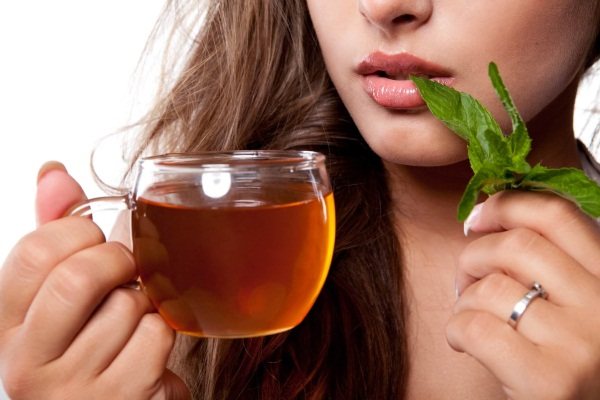

Remove from heat and wrap with a thick cloth. Leave in a warm place for an hour. Take the broth in tablespoons, 2-3 tablespoons in the morning and evening. But not more than two weeks, otherwise side effects or allergic reactions may appear.
But for those who have chronic diseases of the cardiovascular system, it is categorically contraindicated to take elecampane without the advice and approval of a doctor. Uncontrolled intake of the drug can be fatal.
To prevent a viral epidemic
To enhance immunity, dissolve and chew a piece of root in the morning and evening. In the case of a severely weakened organism, repeat the procedure for 3 days. It is allowed to start the course every season, if necessary. The broth improves the general condition of the body and enhances immunity.
Against parasites and bacteria
Mix 7 grams of root with 250 ml of alcohol, close tightly. Remove to a dark place for 14 days. Drink the medicine with teaspoons, it is better to write before taking, three times a day. Continue to take the broth until the body is fully restored. In addition to worms, this tincture eliminates toxins and waste products of parasites.
Tincture
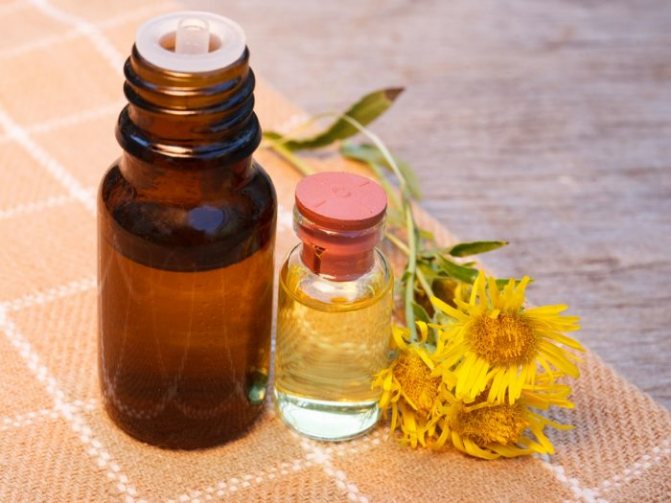

Elecampane tincture. In the fight against diseases of the respiratory system, tincture from elecampane root will help. For its preparation, 100 ml of crushed raw materials should be poured with 250 ml of 40-60% alcohol, left in a dark place for at least a week, then filtered. Take several times a day, half a teaspoon. After diluting with water, the tincture should be used to wash acne-prone skin.
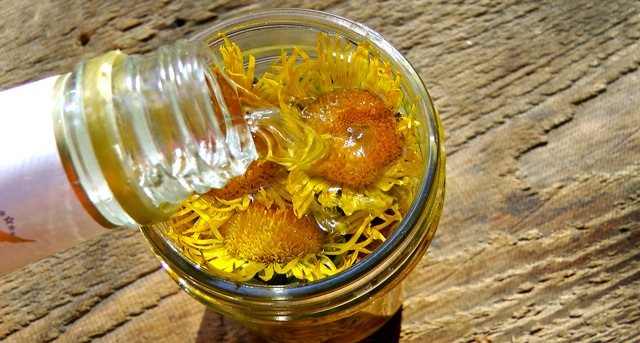

Tincture of flowers and herbs elecampane works as a strong diuretic, anti-inflammatory, relaxes the smooth muscles of the gastrointestinal tract. Has a sedative effect and improves heart function (prevents angina pectoris). To prepare the tincture, it is necessary to pour the flowers of the plant with 40-60% alcohol in a ratio of 1: 3. Take twice a day at a dose of 10 ml.
How to properly procure and store elecampane?
It is recommended to collect the medicinal plant from spring to autumn. The root is best harvested in mid or late September, then it will be most useful for the body. By autumn, the root picks up all the useful substances, ripe, ready to be harvested.
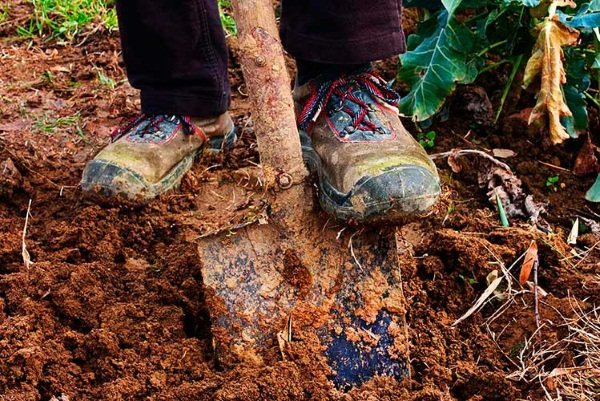

The aerial part is collected in the middle of summer, when the flowers are actively blooming, and the bees pollinate the inflorescences. Spring, preferably March-April, is also good for harvesting the top of the elecampane.
It is quite simple to collect the rhizome, you should dig it up and separate the rotten parts from the healthy root. The upper part should be cut off with a sharp tool at a height of 20 cm from the ground. Make sure that rotten, damaged flowers do not get to healthy ones.
Before drying the rhizome, it must be cut into thin slices of 10 cm. Drying should be carried out at a temperature not exceeding 40 ° C. The top is dried at 50 ° C.
The collection should be stored in a cloth bag in a dark place, out of moisture and sunlight.
The healing properties of elecampane surpass all common fees. The root will cure colds and boost immunity. The body will become stronger and more resistant to disease. It is great if natural medicines in the form of various herbal preparations come to the aid of the body.
Article design: Mila Friedan
Description, distribution, procurement method
Elecampane is a perennial of the Asteraceae family, a close relative of asters.
A small, furrowed, strong stem grows up to two meters. Long lower leaves are alternate. They are densely pubescent, velvety to the touch. The upper leaves are lanceolate, less large, rigid.
The ends of the stems are decorated with yellow flowers collected in baskets.
A valuable doctor hides underground: a knobby, fleshy, brown outside, whitish rhizome inside. It is used in official and traditional medicine.
Finding elecampane is easy... It is distributed throughout the territory of central Russia, it is found in Central Asia, in the Caucasus.
Feels great on personal plots, but is picky about the soil: it will give a good harvest of roots and rhizomes on well-fertilized peat or loamy beds.
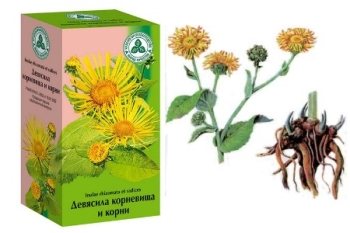

Mass flowering begins in the second year of life... Lasts from July to the end of September.
The beginning of fruiting - the appearance of a brown tetrahedral capsule with a grayish hairy tuft in place of a flower - is a signal for the preparation of medicinal raw materials. It is carried out before the start of frost.
Elecampane can be harvested in early spring, but the healing properties are considered less pronounced.
Preparation method:
- dig up the rhizome along with the roots. To do this, dig in the plant to a depth of 30 cm within a radius of up to 25 cm from the stem;
- remove the earth, rinse, wither a little;
- divide into small pieces;
- dry with good ventilation, stir occasionally.
Properly prepared roots break easily.
This is a photo of a medicinal herb elecampane, just below we will consider the medicinal properties of its roots and contraindications:
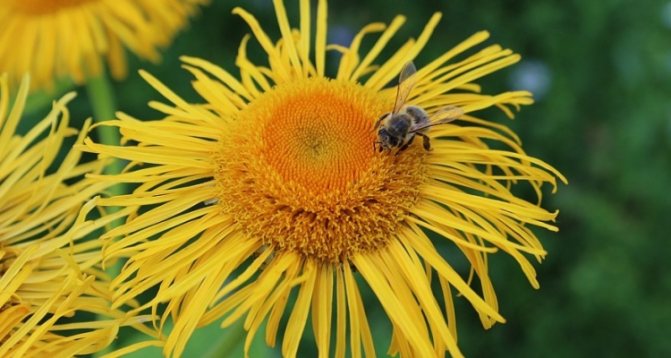

Dosage forms of drugs
Preparations, which include elecampane, are prescribed for concomitant therapy with:
- oncological diseases;
- metabolic disorders in the body;
- joint problems;
- pinching of the sciatic nerve;
- low hemoglobin.
List of known drugs:
- "Elecampane P" (Russia). One hundred tablets of a natural remedy are prescribed for colds, bile stasis and stomach cramps. Elecampane cryopowder is supplemented with vitamin C.
- "Elecampane" (Ukraine). It is produced in the form of filter bags of 4 g each. It consists of elecampane rhizomes and roots. The drug is prescribed for coughs and colds.
- "Elecampane" with bear bile (Russia). The release form of the drug is a cream-balm in an aluminum tube. It is used to treat joints, relieve swelling and pain in their area.
- "Elecampane Syrup" fortified (Kazakhstan). Each bottle contains 125 ml of cold remedy. It contains elecampane roots and rhizomes, vitamin C and rose hips.
- Cream-balm "People's Healer" (Russia). It is used for psoriasis and lichen. After water procedures, the cream is applied to problem areas of the body.
Elecampane to children: at what age
Elecampane is a good but very powerful medicine. If you miscalculate the dose, you can get severe poisoning even for an adult.
If you decide to give a decoction or tincture of elecampane to a child, be sure to consult with your doctor before this and specify the dosage. If the doctor, seeing the clinical picture as a whole, forbade taking elecampane for any reason, listen to a specialist.


For severe coughing, children are advised to give elecampane syrup
Do not give drugs or decoctions with elecampane to infants and children with certain heart or kidney diseases.
But starting from 5-6 years old, you can give children a syrup or a decoction of elecampane, but with strict adherence to the dosage.
Main application
Elecampane has found application not only in medicine, but also in the food, confectionery, and also the alcoholic beverage industry. Some sources contain data on its use in dietary nutrition. Soups and compotes are prepared from the underground part of the plant.
Elecampane can be used instead of ginger for flavoring culinary products, for canning, as a spice or food additive.
The infusion is used for external processing. It is effective for eczema, inflammation, irritation.
The dried and crushed product can be purchased at the pharmacy. The instructions most often indicate the use only as a mucolytic agent. Recently, biologically active additives from various manufacturers have begun to appear, their field of application is somewhat wider.
Growing area
The territory in which elecampane feels comfortable is quite extensive. It grows in Eurasia and Africa. With such a wide range, it is really possible to meet elecampane in the Chinese and Mongolian expanses.
They are well acquainted with him in the West of Siberia, Altai and the Middle East. It also pleases the inhabitants of the Caucasus with its sunny petals. The elecampane looks especially impressive against the background of mountain streams.
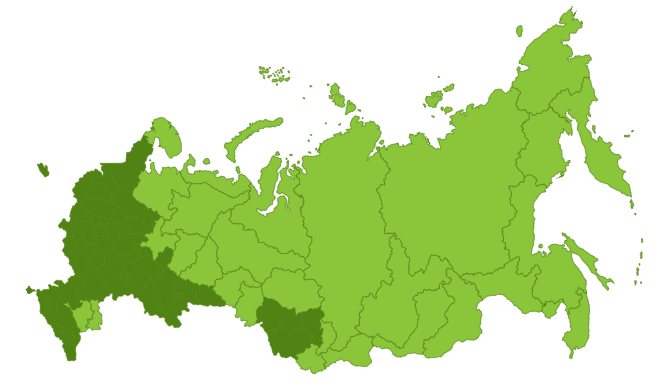

Regions of distribution on the map of Russia
The benefits of rhizomes
The healing properties of high elecampane are multifaceted. This unique plant occupies an honorable first place among medicinal herbs that have a therapeutic effect in stomach pathologies.
Medicines from elecampane can induce appetite, normalize digestion. This plant regulates the secretory function of the gastrointestinal tract, and also relieves spasms. The drugs stimulate metabolism.
Elecampane has the following effect:
- Antiviral.
- Antibacterial, including fighting Staphylococcus aureus.
- Expectorant.
- Diuretic.
- Choleretic.
- Antidiarrheal.
Elecampane helps to get rid of parasites, including fighting roundworms. Medicines from the plant are used as an antiseptic.
The use of elecampane high is also possible with some oncological pathologies of a malignant type: leukemia, gastrointestinal cancer. Elecampane is able to treat metabolic disorders, helps with gout, arthritis, sciatic nerve inflammation. It is also used in complex therapy for anemia.
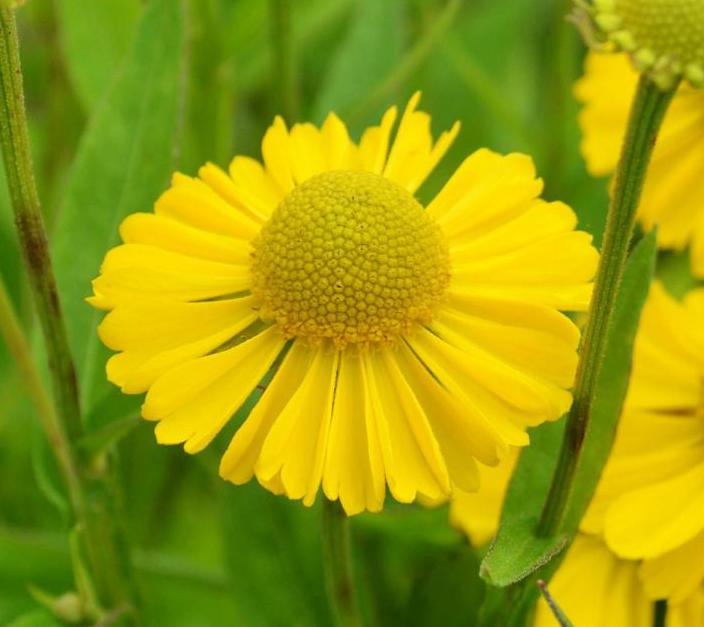

How to prepare raw materials
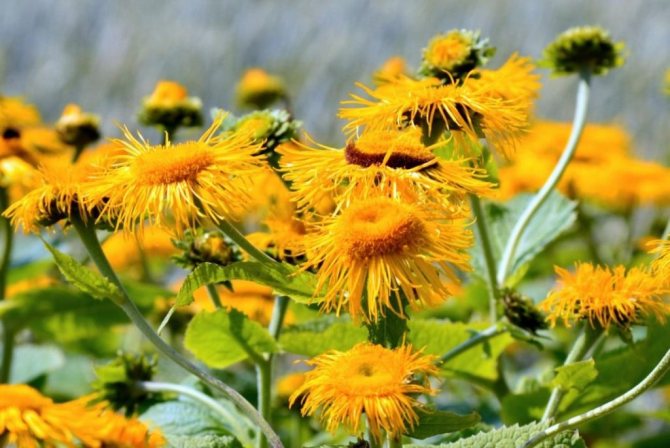

The process is carried out using a shovel, which will have to dig out the required number of elecampane rhizomes. The right time for this would be August - September. An alternative to autumn will be April, when the roots can also be harvested before the vegetative growth of elecampane begins. For preservation, reproduction is recommended for 1 sq. m leave at least 1 rhizome. The most usefulness is not in the upper part of the rhizome, so you need a root with a depth of at least 30 cm.
It is recommended to dig up the roots of a plant that is at least 3 years old, and the leaves on the contrary will be useful from a young elecampane. It is better to collect flowers and leaves during the period of active flowering of the plant.
Digging, collecting and drying
Having dug out the rhizomes, you need to clean them from the ground, rinse with water, and deprive the damaged areas.Next, the material is cut into small slices or circles and subjected to a drying procedure. To begin with, the raw material is laid out in the open air, leaving it for a couple of days, covering it from the effects of precipitation. After that, the contents are placed in rooms with ventilation, which can allow maximum ventilation, preventing overmoistening of the air. Drying in the sun can be an alternative to this method. This procedure is permissible only in dry summers, when the air is not saturated with humidity. The readiness for storage is determined by the fragility of the roots. When the raw material reaches its condition, dries up, it is placed in fabric bags and stored in a dry, cool place. Zelenka elecampane, in particular grass, is removed selectively, not by total cutting. This is necessary so that the elecampane does not die, and then continues to grow. Flowers, leaves dry well in the open air, in ventilated areas, after which they are packed in paper bags for a shelf life of up to 3 years.
Growing elecampane from seeds
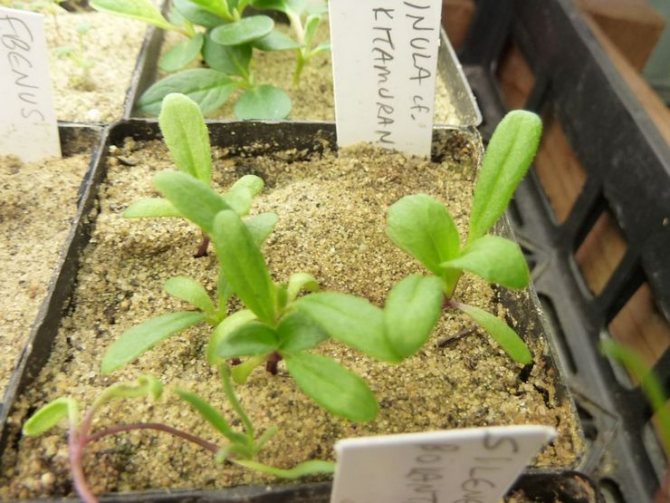

It is recommended to plant elecampane seeds after May 15, or at the end of November. If the seeds were purchased at a store, then carefully study the date on the package. They can be stored for no more than 4 years. As a rule, before sowing, it is advised to mix the seeds with sand in a 1: 1 ratio. About 150-200 pieces will be needed per meter of plot in 1 row. The grooves should not be deeper than 3 cm, and the distance between the rows should be at least half a meter, otherwise the root of the plant will not have enough room for growth. When filling the seeds of elecampane with soil, do not press down strongly, let the air penetrate deep into it.
When planting elecampane seeds, leave a distance of at least half a meter between the holes, since you will not have to re-plant.
After 2 weeks, the first shoots will appear, and when the height reaches 5 cm, they should be planted 12-15 cm apart. After the seedlings have developed into strong bushes, the transplanting process should be repeated so that the root system can develop well.
There is a second way to reproduce and grow elecampane - by dividing the rhizome. To do this, you need to take the root of an adult shrub and divide it. It is better to do this in the spring or as soon as the bud fades. A bud of renewal should remain on the rhizome of the plant, and the aerial part should be carefully removed. Rinse the root thoroughly under a stream of cool water, and plant it in the ground at a depth of at least 6 cm, and after digging in, be sure to moisten the soil.
Elecampane for infertility: a recipe
Such a terrible diagnosis as infertility terrifies many women. Someone hearing him falls into despair, while for someone he does not interfere with life at all. Nevertheless, with the diagnosis of infertility, a woman sooner or later begins to feel inferior.
After going through lengthy and expensive examinations, sometimes it is possible to find the cause of infertility and eliminate it, but in some cases, doctors shrug their shoulders. Unfortunately, this happens much more often than we would like. Therefore, many women, having lost faith in modern medicine, turn to folk medicine.


The desire to have children is natural for a woman
It is real to cure infertility with elecampane, and the reviews say the same. All you need to do is follow the instructions below clearly.
- Prepare a decoction of elecampane rhizomes: pour 20 g of dry roots with a glass of water.
- Simmer the mixture for 15 minutes over low heat.
- Let it brew for 4 hours, then strain and cool.
- Take a decoction in phase 2 of the cycle 3 or 4 times a day for a tablespoon 20-30 minutes before meals.
How it works? The presence of special substances in the roots of the elecampane is a favorable condition for the attachment of the embryo to the wall of the uterus.
Important! Do not drink this broth if you are not sure that there is no pregnancy. Elecampane can provoke a miscarriage.


Infertility is a terrible diagnosis
Not only a decoction of elecampane will help the early onset of pregnancy, but also a tincture.
To prepare a tincture of elecampane for fertility treatment, follow these steps:
- Take 1 part chopped elecampane root, burdock leaves, and dandelion leaves. Stir.
- Take 2 tablespoons of the herbal mixture and cover it with 60% alcohol up to the top.
- Insist for 21 days, shaking the tincture every day.
- You can take 2 and 4 tablespoons or more. It all depends on how long you plan to take the tincture.
- Take the finished tincture 2 tablespoons (50 ml) twice a day.
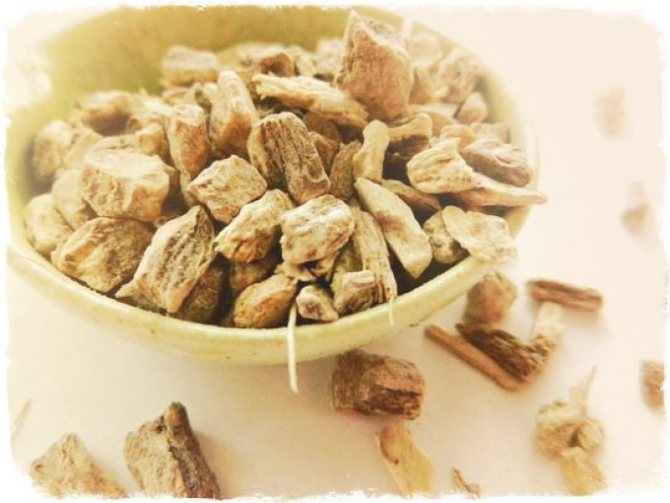

Elecampane roots for fertility treatment
If pregnancy does not occur, contact a good specialist. Self-medication is very dangerous!
Elecampane in the treatment of gastrointestinal diseases
A decoction of the root helps well with pathologies of the gastrointestinal tract. It is used in the following cases:
- For stomach pains.
- With flatulence.
- Elecampane helps to cope with colitis.
- Recommended for loss of appetite and sluggish digestion.
- With jaundice, diseases of the gallbladder.
To prepare the broth, take a spoonful of the root and fill it with a glass of water. The product is boiled for fifteen minutes over low heat, then infused for four hours. The broth is taken warm in a tablespoon three times a day.
Elecampane high
A perennial herb that has an expectorant, anti-inflammatory, choleretic, antispasmodic, diuretic, hemostatic, tonic, anthelmintic, antifungal effect.
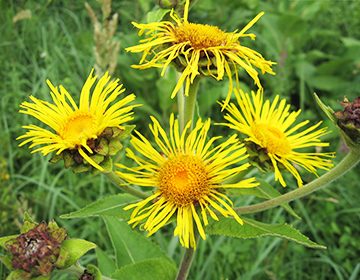

The healing properties and contraindications of elecampane were known to ancient healers - Avicenna, Pliny, Hippocrates. In the old days, they were treated for malaria, headaches, epilepsy, urolithiasis. People call this plant nine-strength, which characterizes its powerful healing effect. It is often used in traditional medicine and homeopathy. In traditional pharmacology, the plant is found in the following dosage forms: dry raw materials in the form of powder and in filter bags, tablets, cream-balm, herbal tea.
Cooking method
Folk wisdom has brought to our days recipes for tinctures on water, vodka or red wine:
- A tablespoon of raw materials is placed in a ladle, 200 ml of hot water is poured, covered with a plate, kept in a water bath for half an hour. Then the liquid is cooled, filtered, and the volume is adjusted to 200 ml. They drink 100 grams three times a day, store for no more than 2 days.
- 30 grams of chopped elecampane is placed in a thermos, poured with boiling water, insisted for an hour and a half, filtered.
- Two tablespoons of the powder are poured into a bottle with a high-quality alcohol-containing drink and left for 4-5 days. Traditional herbalists prepared such a tincture for headaches, palpitations and whooping cough.
- Pour a bottle of red wine into a saucepan, pour three tablespoons of the root into it, put on fire, bring to a boil. Cool the resulting product, strain through 4 layers of gauze and refrigerate. The liquid is taken at 15 mg to strengthen, treat stomach diseases, increase defenses and tone.
What is elecampane, what does the herb look like, what does it treat?
Residents of central Russia have probably seen elecampane more than once in fields and meadows. The plant is found in forests, on mountain slopes, in river valleys. It is very easy to find elecampane during the flowering period: it has yellow petals, similar to those of a coltsfoot and a light brown core.
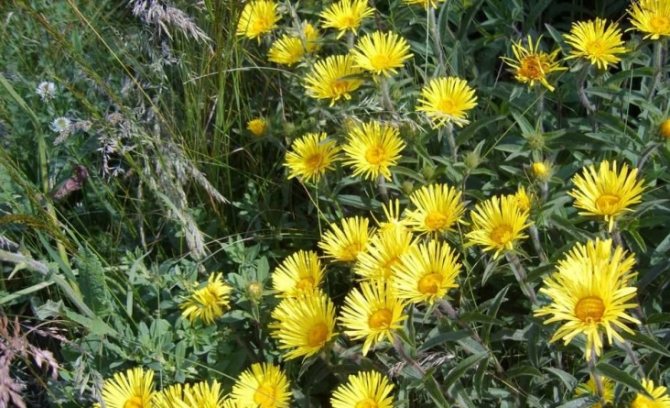

This is how one of the varieties of elecampane grows
For treatment, both flowers and roots of elecampane are used.
Basic actions of elecampane:
- anti-inflammatory
- disinfectant
- wound healing
- diuretic
- expectorant
- anthelmintic
- cleansing
- stimulating
Most often, elecampane is used for diseases of the liver, kidneys, stomach and intestines. Decoctions and infusions perfectly help with a strong cough that flows into bronchitis, localized headache (migraine), pneumonia, skin diseases, menstrual irregularities in women.
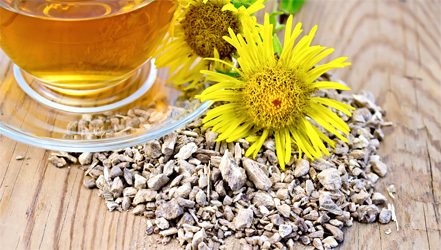

elecampane treatment
Important! As with any medicine, even folk medicine, elecampane has a number of contraindications, which we will discuss later in the article.
Types of plants with photos
Elecampane has only about 200 species, the plant is quite common in Europe, Asia and Africa. In Russia, along with elecampane tall, you can find British and willow.
Elecampane British
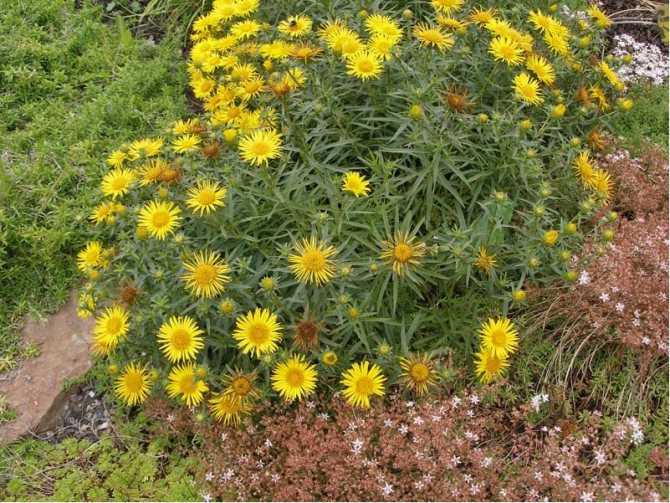

Elecampane British has smaller flowers and much shorter stems than elecampane tall
The plant is up to 60 cm high. Elecampane British is valued for its flowers, which are harvested during their most intense flowering. The flowers contain a beneficial essential oil that is essential to fight liver diseases, nervous system, colds, diabetes and alcoholism.
Elecampane willow
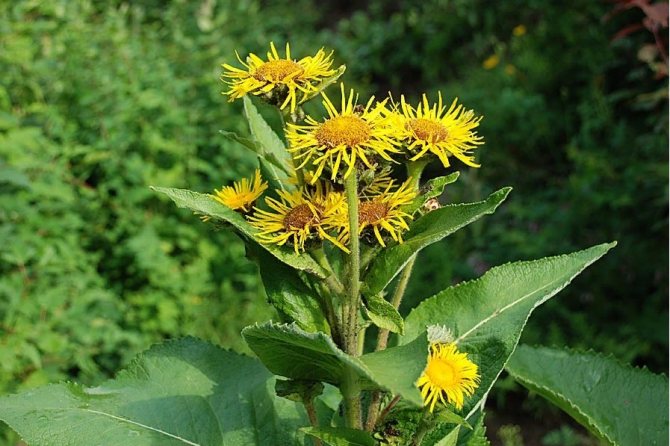

Elecampaneus willow has very large flowers
Elecampaneus willow has larger and tougher leaves than elecampane tall, but its stem is shorter, about 50 cm. For medicinal purposes, people use all parts: flowers, roots, stems.
Means made from this type are used for diseases of the digestive and circulatory systems, skin lesions, colds, snake bites, epilepsy, venereal diseases.
Healing action
What is known about the healing properties of elecampane? The herb is considered universal because it is used to treat many ailments.
Elecampane is a good tonic, which is used for prevention, strengthening the body's defenses in the winter.
Application in gynecology
Elecampane is a medicinal plant for women. It is widely used in gynecology for the following disorders:
- with a delay in menstruation;
- painful periods;
- uterine bleeding;
- discharge (leucorrhoea) of an inflammatory nature.
If all of the above symptoms are found, first of all, you need to contact a gynecologist. Self-medication with folk methods can lead to complications and chronic diseases. What is important to know for women who are trying to be treated with elecampane on their own?
- When using elecampane to call menstruation, a severe disruption of the menstrual cycle can begin.
- Do not use the herb when your period has already begun, because it can lead to uterine bleeding.
- It is strictly forbidden to use elecampane for pregnant women, the plant can provoke a miscarriage.
- Overdose can lead to cardiac arrhythmias, vomiting.


Elecampane for men
In Russia, elecampane was also called "male fidelity." Only women collected and dried the grass, drank the broth themselves and gave it to their husbands. According to legend, Ilya Muromets got out of bed after thirty-three years of lying due to the miraculous properties of this plant. Why is elecampane so useful for men?
- It is used for male infertility.
- Improves sperm quality: increases sperm activity and vitality.
- Treats inflammation of the testicular tissue (orchitis).
To treat male infertility and improve the quality of sperm, tinctures and decoctions are used, which are taken in a long course. With orchitis, it is effective to use elecampane in the form of an ointment, which is made from a decoction of the root and propolis.
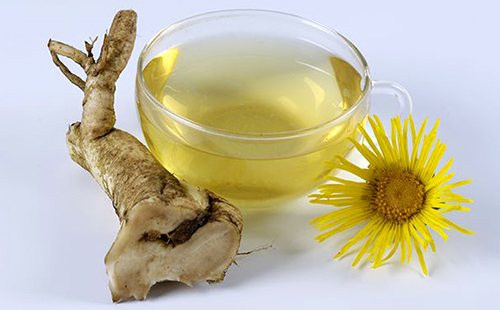

Healing raw materials
For medical purposes, the roots of elecampane are used. They are harvested in autumn - in September or early spring - in March.
Raw materials are characterized by the following indicators: pieces of roots are mostly longitudinally split, of various shapes. Pieces of rhizomes 2-20 cm long, 1-3 cm thick, outside gray-brown, inside yellowish-white, with a peculiar aromatic smell, spicy, bitter, burning taste. The moisture content of raw materials should not exceed 13%.
The use of other types of elecampane is also allowed:
- Elecampane huge, or large (Inula grandis) in the modern classification stands out as Eastern elecampane (Inula orientalis);
- Elecampane magnificent (Inula magnifica);
- Elecampane British (Inula britannica).
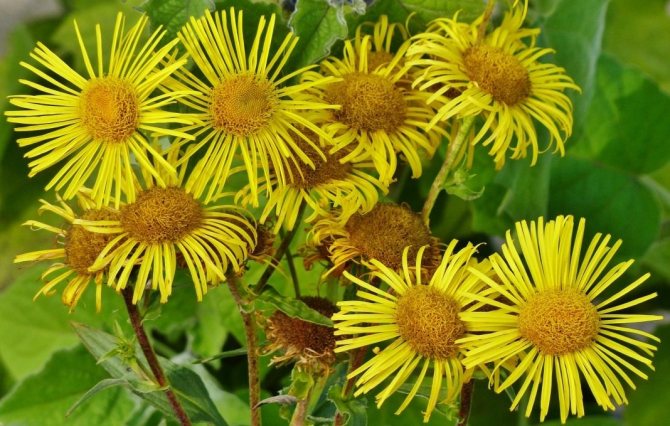

Elecampane British (Inula britannica). <>
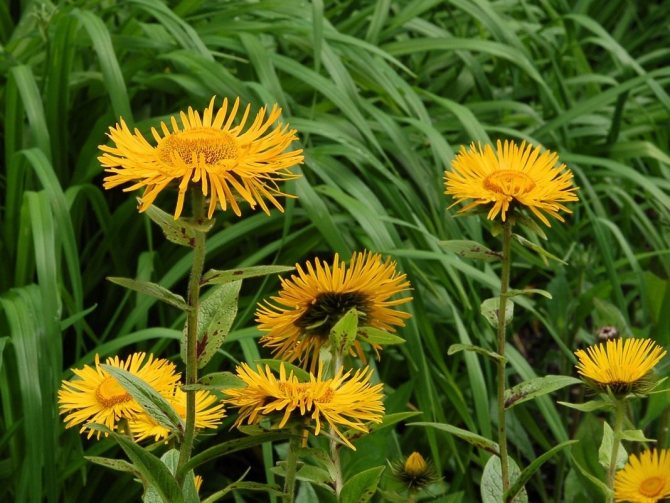

Eastern elecampane (Inula orientalis).
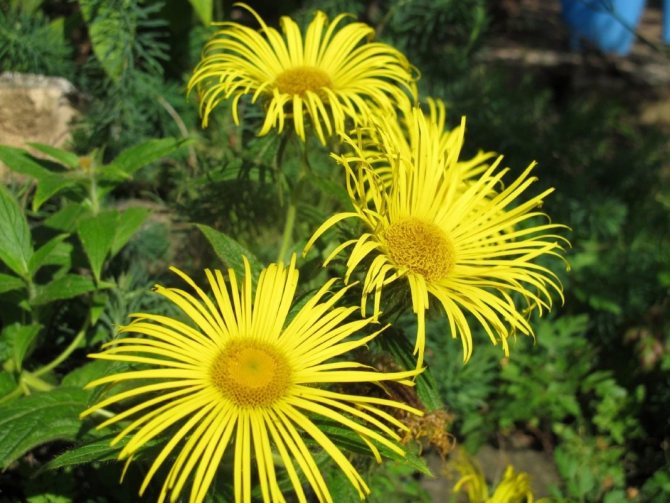

Elecampane magnificent (Inula magnifica).
Elecampane planting and care in the open field
Since under natural conditions the culture grows in forests, on the banks of ponds and meadows, the site for planting it must be chosen so that the garden bed is in a well-lit place, but at the same time without direct sunlight on the plant. Also, it must be protected from drafts.
In order for the bush to be lush, decorative and bloom well, the soil for planting must be loose and nutritious. A garden bed for planting a culture must be prepared in the fall, adding organic matter, peat and sand for digging. If the garden soil is loose and fertile, then urea and phosphorus-potassium fertilizer can be added to it in the fall, and in the spring, before planting, top dressing with a high nitrogen content.
You can grow a culture both from rhizomes and from seed. Planting roots should be carried out in May, so that the plant can take root over the summer and gain aerial leaf mass.
In the first year after planting, elecampane grows by 40 centimeters, and after three years a powerful aboveground bush is formed. Before planting the rhizome, it is divided into parts with one or two vegetative buds. Delenki are planted in shallow holes at a distance of up to 60 centimeters. The roots are buried into the soil by 6 centimeters. Mineral fertilizer is applied to the hole before planting and the soil is moistened. The place of the cut on the dividers is treated with crushed activated carbon and placed in the wells with the kidneys up. After planting, the soil is compacted, watered and mulched with dry peat.
When sowing seed, it does not need to be stratified, this is the advantage of this planting method. It can be sown both in spring and in autumn in small long planting dimples to a depth of two centimeters, retreating between rows of 45 centimeters. Before sowing seeds, the soil must be moistened.
The first shoots appear in two weeks, and when the plants reach a height of 6 centimeters, they will need to be thinned out. Re-thinning should be done after the bushes have grown.
